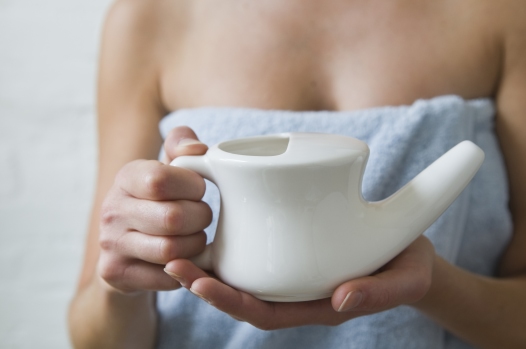52% of US households have at least six detectable allergens, all of which can float through the air and find their way into your body (Journal of Allergy and Clinical Immunology). These irritants include animal dander, dust mites, mold, scented candles, cleaning products, and cigarette smoke. Once again, these allergens probably won’t spark much of a histamine reaction in a healthy immune system, but when it’s hypersensitive they’ll set off a host of five-alarm symptoms.
The Fix: In all cases, use a nasal rinse once a day, twice a day if you are really suffering; this flushes irritants out of your nasal passages and soothes swollen sinuses. You can purchase a salt solution or make a nasal rinse solution by adding a teaspoon of sea salt and a pinch of baking soda to a quart of warm water. Use a Nasaline or Netti pot to push the solution through your nose; we have found the Nasaline easier and faster than the Netti.
Get tested – determine exactly what you are intolerant too so you can eliminate it and allow your body the time it needs to heal. Once your immune system rebalances, it is unlikely you will have the same reaction to these items. You can have some allergens tested at your medical practitioner’s office; an Lymphocyte Response Assay test will provide additional benefits.
Dust Mites – Replace carpeting with hardwood and limit upholstered items and fabric hangings like wall tapestries or drapes. Enclose pillows, mattresses, and box springs in allergen-proof covers, and wash bed sheets, mattress pads, and blankets in 130-degree water every week. Also, put pillows I the dryer on high heat for 45 minutes once a week –the heat kills the dust mites. Every six weeks, wash any stuffed animals in hot water or stick them in plastic bags and freeze them overnight to kill off the mites.
Animals – Pet dander contributes a large share of household allergens. Cats are actually worse than dogs because their dander is lighter and clings to everything. Swap carpeting for hardwood, keep your little creatures off upholstered furniture and invest in a HEPA air filter, which reduces dander in the air.
Mold – The best way to reduce mold in your house is to keep the temperature around 68 degrees and the relative humidity about 35 percent. Keep indoor plants on the dry side (mold tends to grow in the potting soil) and ban plants from the bedroom (where you spend up to a third of your life). Place a dehumidifier in damp basements or crawl spaces during the summer.
Airborne chemicals – Switch to natural cleaning products, avoid synthetic fragrances in scented candles, detergents, deodorants; quit smoking.


